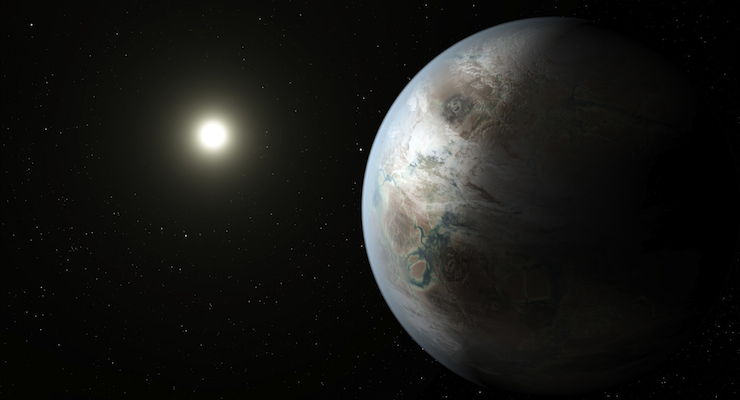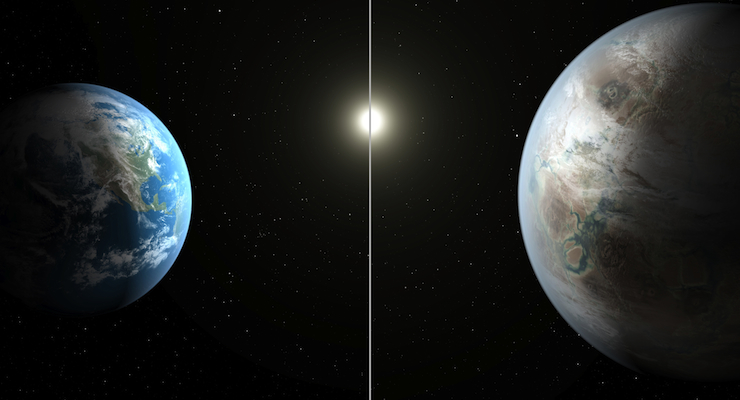

This artist’s concept compares Earth (left) to the new planet, called Kepler-452b, which is about 60 percent larger in diameter. (Photo: NASA/JPL-Caltech/T. Pyle)
NASA’s Kepler mission has confirmed the first near-Earth-size planet in the “habitable zone” around a sun-like star, marking another huge milestone in the effort aimed at “finding an Earth 2.0.” This discovery comes as NASA announces the introduction of 11 other new small habitable zone candidate planets.
The newly discovered planet — named Kepler-452b — is the smallest discovered orbiting in the habitable zone to date. The habitable zone, sometimes referred to as Goldilocks Zone, is the area around a star where liquid water could pool on the surface of a planet orbiting a G2-type star, or like our sun. The confirmation of Kepler-452b brings the total number of confirmed planets to 1,030.
“On the 20th anniversary year of the discovery that proved other suns host planets, the Kepler exoplanet explorer has discovered a planet and star which most closely resemble the Earth and our Sun,” said John Grunsfeld, associate administrator of NASA’s Science Mission Directorate at the agency’s headquarters in Washington. “This exciting result brings us one step closer to finding an Earth 2.0.”
By comparison, Kepler-452b is 60 percent larger in diameter than Earth and is considered a super-Earth-size planet. NASA says that the mass and composition are not yet determined, but previous research indicate that planets the size of Kepler-452b have a good chance of being rocky.
Even though Kepler-452b is larger than Earth, its 385-day orbit is only 5 percent longer than ours, and it is 5 percent farther from its parent star Kepler-452 than Earth is from the Sun. Kepler-452 is 6 billion years old, which is 1.5 billion years older than our sun, yet has the same temperature and is 20 percent brighter with a diameter 10 percent larger.

This artist’s concept depicts one possible appearance of the planet Kepler-452b, the first near-Earth-size world to be found in the habitable zone of star that is similar to our sun. (Photo:: NASA/JPL-Caltech/T. Pyle)
“We can think of Kepler-452b as an older, bigger cousin to Earth, providing an opportunity to understand and reflect upon Earth’s evolving environment,” said Jon Jenkins, Kepler data analysis lead at NASA’s Ames Research Center in Moffett Field, California, who led the team that discovered Kepler-452b. “It’s awe-inspiring to consider that this planet has spent 6 billion years in the habitable zone of its star; longer than Earth. That’s substantial opportunity for life to arise, should all the necessary ingredients and conditions for life exist on this planet.”
Jenkins said that the team conducted ground-based observations at the University of Texas at Austin’s McDonald Observatory, the Fred Lawrence Whipple Observatory on Mt. Hopkins, Arizona, and the W. M. Keck Observatory atop Mauna Kea in Hawaii to confirm the finding and better determine properties of the Kepler-452 system. The measurements they found were key in confirming the planetary nature of Kepler-452b, to understand the size and brightness of its host star and to better determine the size of the planet and its orbit.
The Kepler-452 system is located 1,400 light-years away in the constellation Cygnus.
Discover Earth-Like Kepler-452b in Five Graphics
In addition to confirming Kepler-452b, the Kepler team has increased the number of new exoplanet candidates by 521 from their analysis of observations conducted from May 2009 to May 2013, raising the number of planet candidates detected by the Kepler mission to 4,696. Candidates require follow-up observations and analysis to verify they are actual planets.
Twelve of the new planet candidates have diameters between one to two times that of Earth, and orbit in their star’s habitable zone. Of these twelve new planet candidates, nine orbit stars that are similar to our sun in both size and temperature.
“We’ve been able to fully automate our process of identifying planet candidates, which means we can finally assess every transit signal in the entire Kepler dataset quickly and uniformly,” said Jeff Coughlin, Kepler scientist at the SETI Institute in Mountain View, California, who led the analysis of a new candidate catalog. “This gives astronomers a statistically sound population of planet candidates to accurately determine the number of small, possibly rocky planets like Earth in our Milky Way galaxy.”
These findings, presented in the seventh Kepler Candidate Catalog, will be submitted for publication in the Astrophysical Journal, where it has already been accepted for publication. These findings are derived from data publicly available on the NASA Exoplanet Archive.
Scientists now are producing the last catalog based on the original Kepler mission’s four-year data set. The final analysis will be conducted using sophisticated software that is increasingly sensitive to the tiny telltale signatures of Earth-size planets.
Ames manages the Kepler and K2 missions for NASA’s Science Mission Directorate. NASA’s Jet Propulsion Laboratory in Pasadena, California, managed Kepler mission development. Ball Aerospace & Technologies Corporation operates the flight system with support from the Laboratory for Atmospheric and Space Physics at the University of Colorado in Boulder.







